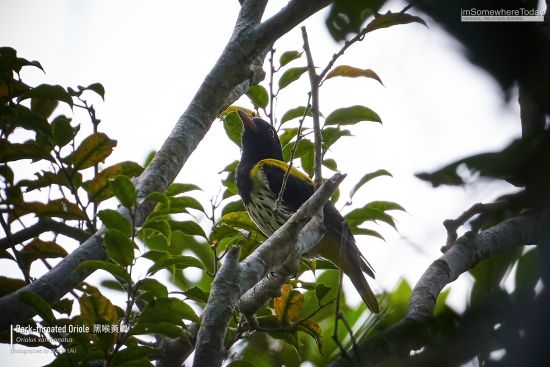| This article is incomplete. This article is missing one or more sections. You can help the BirdForum Opus by expanding it. |
- Oriolus xanthonotus
Identification
17-19 cm. Fairly typical small oriole, male distinguished by black "hood".
- underparts with coarse black spots aligned longitudinally to form loose streaks
- lower back, upper and under tail coverts yellow
- tail dark with under tail terminal yellow spots on central feathers
- bill pink
- eye (dark) red
- eye ring narrow, may appear grey or yellowish
- legs and feet grey
Male
- head, wings and chest black forming a "hood"
- tail black where not yellow
- back and mantle yellow
Female
- crown may have light longitudinal streaking
- chest and throat streaked like rest of underparts
- greener (more olive) than male, for example on upper tail
- upper parts mostly olive green or greyish. Head generally more grey than mantle, wings
- primaries dark
Similar species
Ventriloquial Oriole has male greener, female with a markedly dark greyer-green head.
Distribution
Southeast Asia: found in from Myanmar, Thailand, Malaysia, Malay Peninsula, to Brunei, Borneo, Sumatra and Java (Greater Sundas).
Taxonomy
Ventriloquial Oriole was formerly considered a part of Dark-throated Oriole.
Subspecies
Clements recognises the following subspecies [1]:
- O. x. xanthonotus: Southern Myanmar, Thailand, Malaysia, Sumatra, south-western Borneo and Java
- O. x. mentawi: Mentawi Archipelago and adjacent islands off Sumatra. [Female with darker crown with blackish feather centers]
Habitat
Lowland evergreen and swamp forest and forest edges to 1,220m.
Behaviour
The diet includes fruit and insects.
References
- Clements, J. F., P. C. Rasmussen, T. S. Schulenberg, M. J. Iliff, T. A. Fredericks, J. A. Gerbracht, D. Lepage, A. Spencer, S. M. Billerman, B. L. Sullivan, and C. L. Wood. 2023. The eBird/Clements checklist of Birds of the World: v2023. Downloaded from https://www.birds.cornell.edu/clementschecklist/download/
- Gill, F, D Donsker, and P Rasmussen (Eds). 2024. IOC World Bird List (v 14.2). Doi 10.14344/IOC.ML.14.2. http://www.worldbirdnames.org/
- Avibase
- BirdLife International
- Bird Ecology Study Group
- Eaton, JA, B van Balen, NW Brickle, FE Rheindt 2021. Birds of the Indonesian Archipelago (Greater Sundas and Wallacea), Second Edition. Lynx Editions. ISBN978-84-16728-44-2
Recommended Citation
- BirdForum Opus contributors. (2025) Dark-throated Oriole. In: BirdForum, the forum for wild birds and birding. Retrieved 18 May 2025 from https://www.birdforum.net/opus/Dark-throated_Oriole
External Links
GSearch checked for 2020 platform.1




